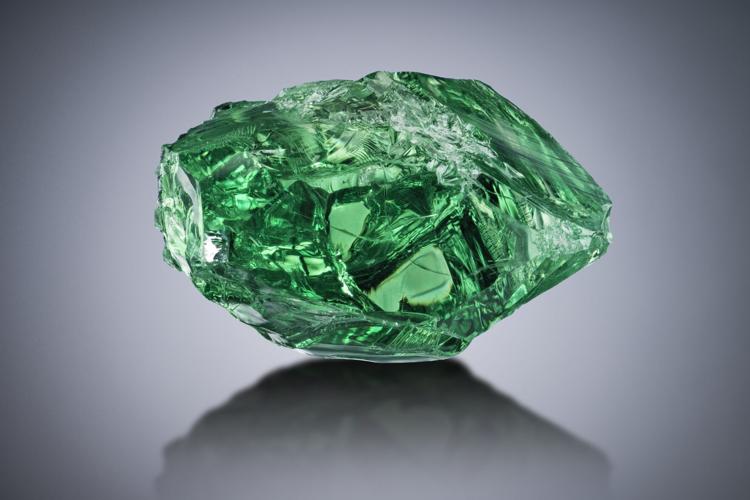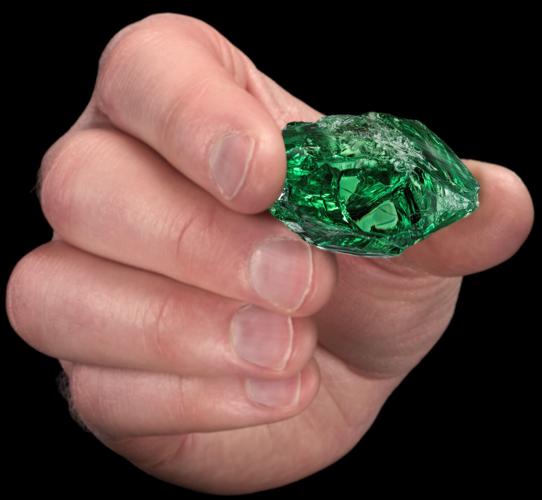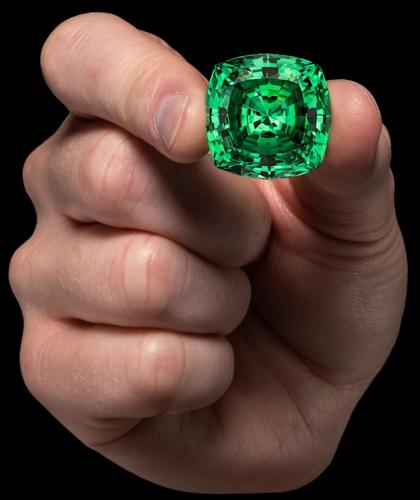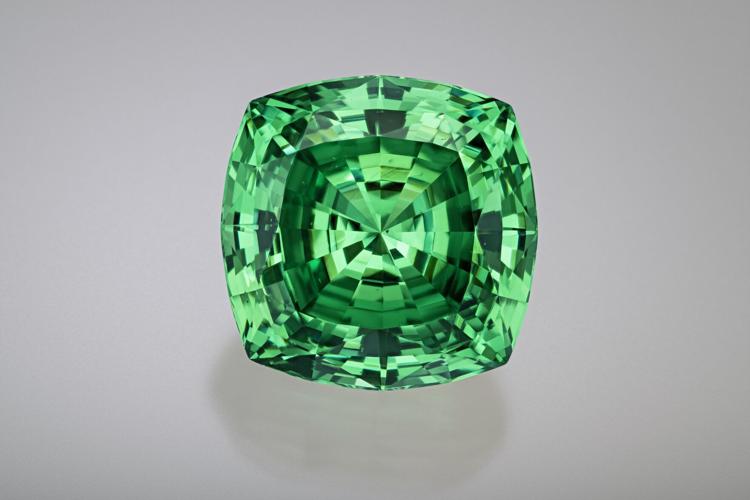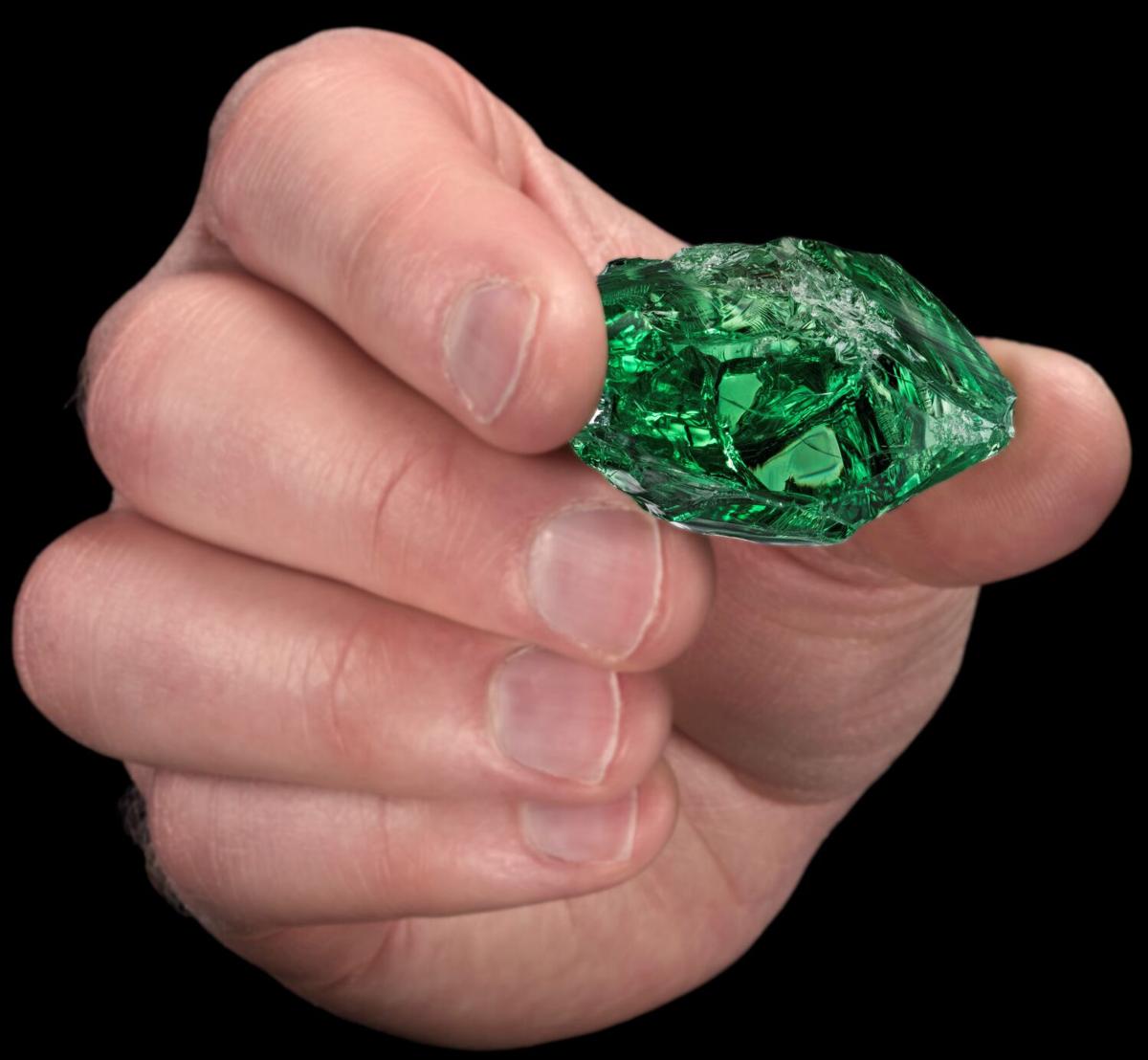One of the world’s largest pieces of bright-green bling is now in the hands of the Smithsonian’s National Museum of Natural History, thanks to some generous Arizona gem experts.
The precision-cut, 116.76-carat tsavorite gem known as the Lion of Merelani was donated to the Smithsonian by Tucson mining businessman Bruce Bridges and Scottsdale-based Somewhere In The Rainbow, a private gem and jewelry collector and exhibitor.
“This tsavorite is truly one of the most important colored gemstones to have been mined this decade,” said mineralogist Jeffrey Post, the Smithsonian’s curator-in-charge of gems and minerals. “A gem like this is one of Earth’s natural treasures and is an exciting addition to the National Gem Collection and to our public exhibition.”
The exceedingly rare, glowing green garnet was mined in Africa and cut in Tucson into a square cushion with 177 mirror-like facets. It went on display at the museum in Washington, D.C., late last month, alongside other famous gems such as the Hope Diamond and the Rosser Reeves Star Ruby.

The 116.76-carat tsavorite gem known as the Lion of Merelani, which was mined in East Africa and cut and finished in Tucson.
“It is quite remarkable, at least in the gem world,” said Bridges, whose gem business, Bridges Tsavorite, is based in Kenya but has its sales office in Tucson. “To have even a 2-plus carat (tsavorite) stone is a rare gem.”
The rough stone weighed 283 carats when it was unearthed in late 2017 near Merelani, an area of northern Tanzania known for its gem deposits.
Bridges said he acquired the massive tsavorite (pronounced sah-vor-ite, with a silent first t) within about three weeks of its discovery, but he declined to say what he paid for it.
His business prides itself on mining rare colored stones and cutting them into finished gems in-house at its facilities in Africa. Bridges said this particular crystal required special tools and a world-renowned pair of hands.
Somewhere In The Rainbow connected him with gemcutter Victor Tuzlukov, a Russia-born grand master who traveled to Tucson from his home in Thailand to do the job. It took three months of planning and one month of cutting to produce the world’s largest square cushion tsavorite and the largest tsavorite gem ever cut in the United States.
Faraway Tucson
Bridges said Tuzlukov warmed up for the main event by cutting two other enormous tsavorite stones — one 31 carats, the other more than 58 carats — that have since been sold to buyers in Asia.
“Either one of those in itself could be the largest stones you will ever see in your life,” Bridges said, except neither are likely to be seen in public again, at least not in North America.
That’s why he was so eager to see the Lion land at the Smithsonian, where millions of people could appreciate its splendor. He said he wanted that for his father, to preserve “his legacy and his dream for tsavorite to be brought to the world.”
Bridges said the Lion of Merelani was named for the place in Tanzania where it was found and in honor of his father, Campbell Bridges.
“He was the king of the colored gemstone world in Eastern Africa,” and he wore a beard for most of his life that made him look a little like a lion, his son said with a laugh. “All of the important gems have got a name.”

Resembling a chunk of green-apple candy, this incredibly rare, 283-carat piece of tsavorite was mined in Tanzania and finished in Tucson into a jewel now known as the Lion of Merelani.
Campbell Bridges discovered tsavorite in northern Tanzania in 1967. When the government of the East African nation blocked his efforts to mine the previously unknown semi-precious stone, the elder Bridges traced his tsavorite deposit into southern Kenya and opened a mine there in the early 1970s. The family has been mining in that area ever since.
Bruce Bridges said he learned about the Old Pueblo at an early age because of the Gem and Mineral Show.
World-renowned gemcutter Victor Tuzlukov shaped and polished the gemstone over the course of a month in Tucson.
“When I was a boy growing up in Africa, my father used to leave for a month and go off to this far-away place called Tucson, Arizona,” he said.
Bridges ended up attending the University of Arizona and earning a varsity letter as a sprinter on the track team, before graduating in 2004 and returning to Kenya to work for the family business.
That’s where he was on Aug. 11, 2009, when Campbell Bridges was murdered in front of him two weeks shy of his 72nd birthday. Bridges said he and his father were traveling on a mine road with four employees when they were ambushed by a mob that had been threatening them and trying to chase them off their holdings for several years.
Bridges said he still travels to Kenya regularly, but he and his wife, Danielle — also a 2004 graduate from UA’s Eller College of Management — are raising their three children in Tucson to keep them safe.
Lion on display
According to the Smithsonian, Post and the rest of the museum’s gem-collection team got their first look at the Lion of Merelani during a secret meeting with Bridges at the Tucson Gem and Mineral Show in 2020. They were astonished by its size and quality.
Post said faceted tsavorites over 10 carats are rare, and this one outweighs the Smithsonian’s second largest specimen of the jewel by more than 100 carats.
As Tuzlukov shaped, cut and polished the stone, Bridges and others filmed the entire process for a documentary that will be shared with the Smithsonian to accent the gem’s display.
World-renowned gemcutter Victor Tuzlukov shaped and polished the gemstone over the course of a month in Tucson.
“We knew this was a once in a lifetime experience for everyone involved,” Bridges said.
“We are confident that this great tsavorite will quickly become a visitor favorite, for its beauty and its well-documented story,” Post said in a written statement. “It will be the iconic garnet in the National Gem Collection, the one that all other tsavorites will be compared to in the future.”
The Lion of Merelani was briefly on public display in Tucson last year at the Alfie Norville Gem & Mineral Museum in the historic Pima County Courthouse downtown.
The UA-run facility features a host of gemstones and jewelry pieces on loan from Somewhere In The Rainbow, which works with museums and galleries to display items from its collection for all to enjoy. Somewhere In The Rainbow partnered with Bridges to keep the Lion in the U.S. and available for public display.
“Their goal is education,” Bridges said of the organization.
The Smithsonian held a public unveiling of the Lion of Merelani on April 20, with guests including Tuzlukov and Somewhere In The Rainbow curator Shelly Sergent. Three generations of tsavorite’s founding family were also in attendance: Bridges, his wife, his children, and his mother, Judith.

The Lion of Merelani, a 116.76-carat tsavorite gemstone, is now on display at the Smithsonian’s National Museum of Natural History in Washington, D.C., after being donated by two Arizona gem experts.
“Tsavorite and my family are just entwined,” Bridges said.


